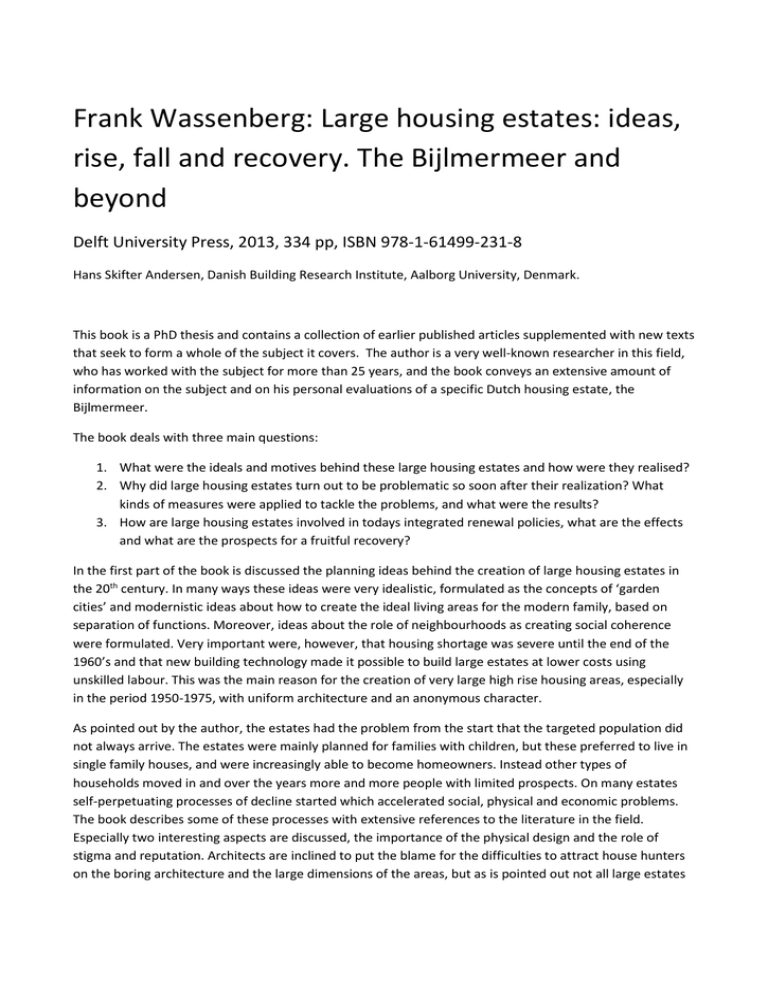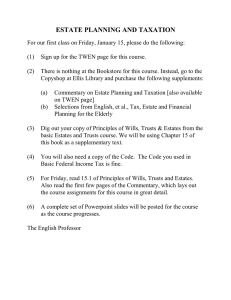Book review Frank Wassenberg
advertisement

Frank Wassenberg: Large housing estates: ideas, rise, fall and recovery. The Bijlmermeer and beyond Delft University Press, 2013, 334 pp, ISBN 978-1-61499-231-8 Hans Skifter Andersen, Danish Building Research Institute, Aalborg University, Denmark. This book is a PhD thesis and contains a collection of earlier published articles supplemented with new texts that seek to form a whole of the subject it covers. The author is a very well-known researcher in this field, who has worked with the subject for more than 25 years, and the book conveys an extensive amount of information on the subject and on his personal evaluations of a specific Dutch housing estate, the Bijlmermeer. The book deals with three main questions: 1. What were the ideals and motives behind these large housing estates and how were they realised? 2. Why did large housing estates turn out to be problematic so soon after their realization? What kinds of measures were applied to tackle the problems, and what were the results? 3. How are large housing estates involved in todays integrated renewal policies, what are the effects and what are the prospects for a fruitful recovery? In the first part of the book is discussed the planning ideas behind the creation of large housing estates in the 20th century. In many ways these ideas were very idealistic, formulated as the concepts of ‘garden cities’ and modernistic ideas about how to create the ideal living areas for the modern family, based on separation of functions. Moreover, ideas about the role of neighbourhoods as creating social coherence were formulated. Very important were, however, that housing shortage was severe until the end of the 1960’s and that new building technology made it possible to build large estates at lower costs using unskilled labour. This was the main reason for the creation of very large high rise housing areas, especially in the period 1950-1975, with uniform architecture and an anonymous character. As pointed out by the author, the estates had the problem from the start that the targeted population did not always arrive. The estates were mainly planned for families with children, but these preferred to live in single family houses, and were increasingly able to become homeowners. Instead other types of households moved in and over the years more and more people with limited prospects. On many estates self-perpetuating processes of decline started which accelerated social, physical and economic problems. The book describes some of these processes with extensive references to the literature in the field. Especially two interesting aspects are discussed, the importance of the physical design and the role of stigma and reputation. Architects are inclined to put the blame for the difficulties to attract house hunters on the boring architecture and the large dimensions of the areas, but as is pointed out not all large estates have come into problems. It could be added that also small low-rise estates have come into problems. Other factors like the local housing market conditions and housing allocation systems can be identified as starting points for the development of negative spirals of decline. This is mentioned in the book but not elaborated in details. Especially one factor has been shown to be very important for these processes, stigmatisation of an estate. Stigmatisation differs between residents and outsiders and has major importance for inclinations to move out or to move in. Especially among outsiders a bad reputation is very difficult to improve, which is one of the main reasons why it is so difficult to change the situation of very deprived estates. Description of interventions to recover the estates, also sometimes called area based initiatives, is in the book concentrated on the case estate, the Bijlmermeer, but a few other examples are shortly described and some general texts are added. The Bijlmermeer is an interesting case because it is extremely large, 13.000 dwellings in very large blocks, and because some drastic efforts have been tried like demolition of half of the estate and to replace high-rise blocks with low rise. Some of the articles in the book describe the reasons for this intervention and the process in which it was carried through. Also some of the effects found in a midterm evaluation are referred. One of the interesting conclusions was that a positive impact on the blocks, which were not demolished, were expected, but the converse occurred. It is concluded, however, that demolition was the only possible solution for the estate as all other measures had proved to be insufficient. Besides this case study, the book contains a review of literature about area based initiatives and the experiences with them. It is underlined, as it has been in many other studies, that integrated approaches, containing physical, social and economic aspects, are necessary to cope with the problems. Some specific recommendations for initiatives are proposed. There is some overlapping in the texts from the different articles and there is not a natural connection between them, but supplementary texts and a good introduction serves as a guideline for the reader. One could object that the problems and processes described in this book is not limited to large and high-rise housing estates but also can be found in many other kinds of urban areas. Large high-rise estates may be more vulnerable than most other neighbourhoods but processes of decline are not restricted to these areas. An important subject, which is not much analysed, is the impact of immigration and concentration of ethnic minorities in vulnerable neighbourhoods. It is well documented (see fx Bramå 2006) that a concentration of ethnic minorities often leads to what is called ‘white flight’ of middle income households. This is a valuable book with deep insight in the subject and a good overview on the extensive research literature from the last 30 years. Bråmå Å. (2006) 'White Flight'? The Production and Reproduction of Immigrant Concentration Areas in Swedish Cities. 1990-2000. Urban Studies 2006 43: 1127-1146.





